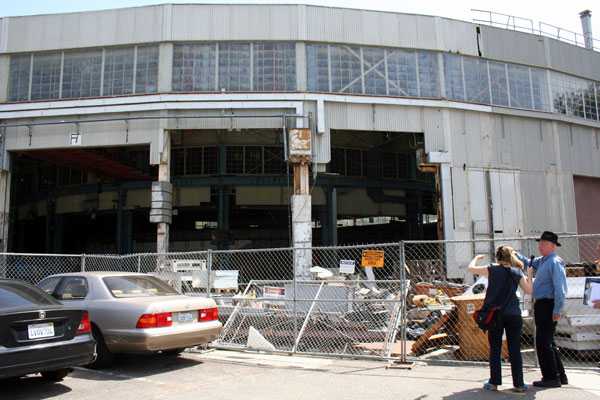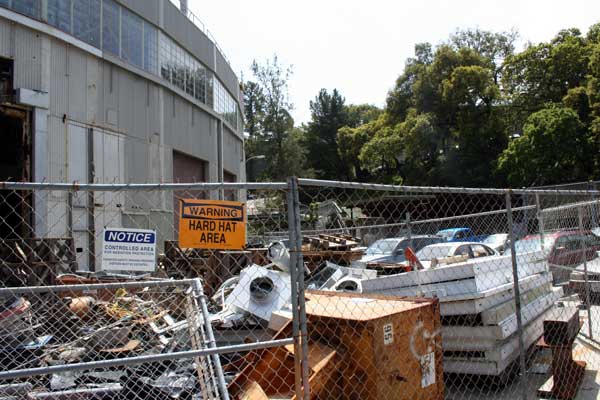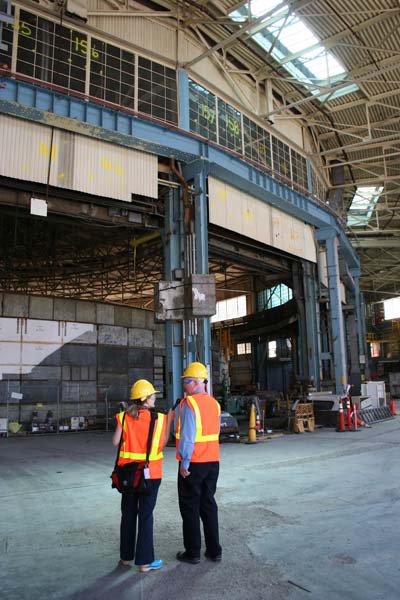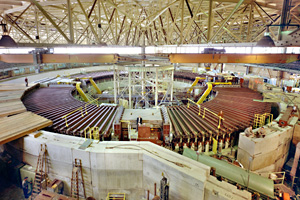Listen to the QUEST radio story Goodbye to the Bevatron.
 With the demolition of the Bevatron, a chapter of the Bay Area's high-level physics research comes to a close.
With the demolition of the Bevatron, a chapter of the Bay Area's high-level physics research comes to a close.
“This was the highest energy accelerator in the world,” says Loken, pointing to the ruins. “It was commissioned with a single goal in mind, which was to produce experimental evidence of the existence of the anti-proton.”
To understand – or at least, approach understanding -- the anti-proton, you have to back up, all the way up to the event that physicists consider the very beginning of the universe, 14 billion years ago: The big bang.
“Any model of the big bang that makes any sense to us creates equal amounts of matter and antimatter from the vacuum,” says Persis Drell, who directs the SLAC National Accelerator Lab, at Stanford.
 Some of the Bevatron’s waste was radioactive, and had to be hauled to hazardous waste sites, such as in Kettleman City.
Some of the Bevatron’s waste was radioactive, and had to be hauled to hazardous waste sites, such as in Kettleman City.
Drell says matter is pretty straightforward. It's what makes up your coffee cup, your brain, the visible universe. But for every subatomic particle that makes up matter, there’s a matching particle, an anti-particle, with the opposite electrical charge.
“When you create matter, you always create an equal amount of antimatter,” Drell says.
Scientists knew the anti-matter had to be out there, but for the most part, they couldn't see it. So, they decided to look for one type of anti-matter in particular, the anti-proton.
“The anti-proton was the thing that would confirm the fact that there is an antimatter world, in addition to the matter world that we see every day,” says Stewart Loken.
In other words, if scientists could produce an anti-proton, it would mean that our understanding of the Big Bang, and the makeup of our universe was basically on the right track. If not, well, it was back to square one.
So, they built the Bevatron to test their theory.
 Five Nobel Prizes were won based on work at the Bevatron, including the 1959 nobel Prize in Physics, for the discovery of the anti-proton.
Five Nobel Prizes were won based on work at the Bevatron, including the 1959 nobel Prize in Physics, for the discovery of the anti-proton.
The experiment began with a thin cloud of hydrogen gas. First, scientists extracted protons from the hydrogen atoms, and injected them into the accelerator chamber. As the protons whipped around and around the chamber they went faster and faster, until they approached the speed of light.
“You want to get to high enough energy that when particles smash together, you can turn that energy into the production of new particles,” says Loken.
Which is exactly what happened. As the particles approached light speed, the Bevatron performed a feat Einstein himself described with the equation E=MC2: That mass and energy are different manifestations of the same thing.
Since mass and energy are essentially interchangeable, the Bevatron was able to transform matter into energy, and energy back into even more matter… including, in 1955, for the first time ever, antimatter.
“We smashed proton against proton and in the end we had proton, proton, antiproton and another proton to balance it out,” Loken says.
This work won Bevatron scientists the 1959 Nobel Prize in physics. It was the first of four Nobels to come from research done here - as well as new insights into things like radiation treatment for cancer, and how to keep astronauts safe from radiation in space.
But by the late 1980s, the Bevatron had become obsolete. In 1993, it closed its doors for good.
Taking down the Bevatron is a huge endeavor. When it's finally demolished, in 2011, it will have cost the country 50 million dollars. Part of the expense will be from removing a protective layer of concrete blocks that kept scientists safe from radiation released by the accelerator. Now, those blocks must be hauled away to hazardous waste sites.
As for the work that in some ways began here… much of it has moved to the Large Hadron Collider in Cern, Switzerland. Where scientists – including from Berkeley – are trying to get a better understanding of how the universe began.
37.8768 -122.251
 With the demolition of the Bevatron, a chapter of the Bay Area's high-level physics research comes to a close. By 1954, ten years after the first atomic bombs leveled Hisroshima and Nagasaki, many of the scientists who had helped develop America’s nuclear arsenal had returned to the US. After years of working on weapons of mass destruction -- and seeing those theories become reality -- many turned to some of the most basic questions imaginable: How did the universe begin? What is it made of?
With the demolition of the Bevatron, a chapter of the Bay Area's high-level physics research comes to a close. By 1954, ten years after the first atomic bombs leveled Hisroshima and Nagasaki, many of the scientists who had helped develop America’s nuclear arsenal had returned to the US. After years of working on weapons of mass destruction -- and seeing those theories become reality -- many turned to some of the most basic questions imaginable: How did the universe begin? What is it made of?
 With the demolition of the Bevatron, a chapter of the Bay Area's high-level physics research comes to a close.
With the demolition of the Bevatron, a chapter of the Bay Area's high-level physics research comes to a close.  Some of the Bevatron’s waste was radioactive, and had to be hauled to hazardous waste sites, such as in Kettleman City.
Some of the Bevatron’s waste was radioactive, and had to be hauled to hazardous waste sites, such as in Kettleman City. Five Nobel Prizes were won based on work at the Bevatron, including the 1959 nobel Prize in Physics, for the discovery of the anti-proton.
Five Nobel Prizes were won based on work at the Bevatron, including the 1959 nobel Prize in Physics, for the discovery of the anti-proton.